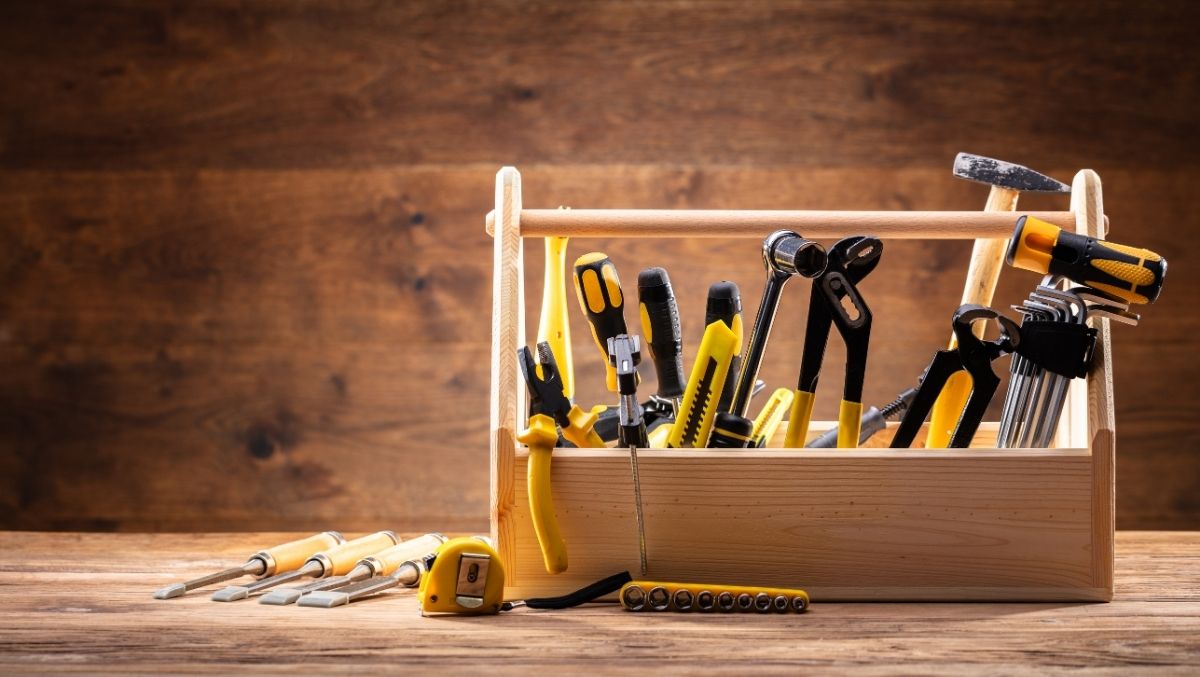How To Extend the Life of Tools
This guide for frugal homeowners offers tool tips for refurbishment, proper storage and rust prevention to help you extend the life of your tools and save money.
by Miranda Jackson

This article contains affiliate links. The Dollar Stretcher is an Amazon Associate and earns a small commission at no cost to you if you click on a link and make a purchase.
For the frugal homeowner, tools are an investment that can allow for basic money-saving DIY home maintenance and repairs. Proper care can extend the life of your tools, ensuring they remain in good working condition for years.
Here’s a quick guide to keeping your tools in top shape, from proper storage to rust prevention and refurbishment.
Refurbish Old Tools
Tools can be costly to replace. Regular cleaning and refurbishment can help you save.
Assess and Repair
Begin by assessing your tools for any wear or damage. Tighten loose handles and screws, and replace worn-out parts like washers or bolts. For wooden handles, sand down any splinters or rough edges and treat with linseed oil to restore the finish and prevent drying out.
Sharpening
Keep cutting tools like shears, knives and mower blades sharp. A dull tool is not only inefficient but can also be dangerous. Use a sharpening stone or a file for smaller tools, and consider a professional sharpening service for larger items like saw blades.
Cleaning
After each use, clean your tools to remove dirt, sap or grease. Use soapy water and a stiff brush for general cleaning. For metal parts, wiping with a rag dipped in mineral spirits can help remove stubborn grime. In a well-ventilated area, dip the steel wool in mineral spirits, rub liberally and watch your tools come back to life. Ensure tools are completely dry before storing them to prevent rust.
Sign Up for Savings
Subscribe to get money-saving content by email that can help you stretch your dollars further.
Twice each week, you'll receive articles and tips that can help you free up and keep more of your hard-earned money, even on the tightest of budgets.
We respect your privacy. Unsubscribe at any time.
Store Gear Properly
Proper storage can protect tools and make it easier to get repair and maintenance tasks done when you can easily find what you need.
Dry Environment
Store your tools in a dry place to prevent moisture accumulation, which can lead to rust and decay. A garage shelf or a tool shed is ideal, but make sure it’s not prone to dampness. Placing silica gel packs or rust-preventing vapor capsules in toolboxes or enclosed cabinets or drawers can absorb excess moisture.
Organized Storage
Invest in affordable storage solutions like pegboards or tool chests. Organizing tools makes it easier to find what you need and prevents tools from being damaged by improper storage. To avoid clutter, hang larger tools and keep smaller ones in drawers or a toolbox with dividers.
Tool Maintenance
Regularly check your storage area for signs of pests, leaks or mold, which can damage your tools over time. Keeping the area clean and well-ventilated can prevent many common issues associated with tool storage.
Keep Tools and Equipment Rust-Free
Don’t let rust and corrosion ruin your valuable tools and equipment. Use these tips to prevent and remove rust.
Coatings
Before long-term storage, apply a light coat of oil or a rust-preventing spray to metal parts. Products like WD-40 or even a light rub-down with an oily rag can protect surfaces from moisture and air that cause oxidation.
Usage and Handling
Handling tools with clean, dry hands or gloves can minimize the transfer of corrosive substances, such as sweat, onto the metal surfaces. Clean and dry tools immediately after use, especially if exposed to moisture or acidic materials.
Regular Inspections
Regularly inspect your tools for signs of rust. Early detection and treatment can prevent further damage. Small rust spots can be treated with a wire brush or sandpaper to remove the rust, followed by proper coating to reseal the surface. For more extensive rust, you may need a cleaner designed for rust removal.
Increase the Shelf Life if Your Tools and Save
By implementing these straightforward maintenance routines, homeowners can significantly extend the lifespan and performance of their tools. Caring for your tools saves money in the long run and enhances the overall safety and efficiency of home maintenance and repair tasks. With just a bit of effort, your toolkit will remain a reliable resource for many years.
Reviewed April 2024
Popular Articles
- 7 Habits of Highly Frugal People
- 5 Simple Budget Cuts That Can Save $200 a Month
- How to Track Down Unclaimed Funds Owed You
- 32 Ways to Save Money on Your Utility Bills
- Do You Need Credit Life Insurance When Buying a New Car?
- How to Maximize Profits When Selling Online
- Staying Motivated to Continue Digging Yourself Out of Debt
On After50Finances.com
- 9 Things You Need to Do Before You Retire
- You Didn’t Save Enough for Retirement and You’re 55+
- When Empty Nesters Reorganize and Declutter Their Home
- Reinventing Your Career in Your 50s or 60s
- What Mature Homeowners Should Know about Reverse Mortgages
- 2 Reasons to Collect Social Security Benefits As Soon As Possible

